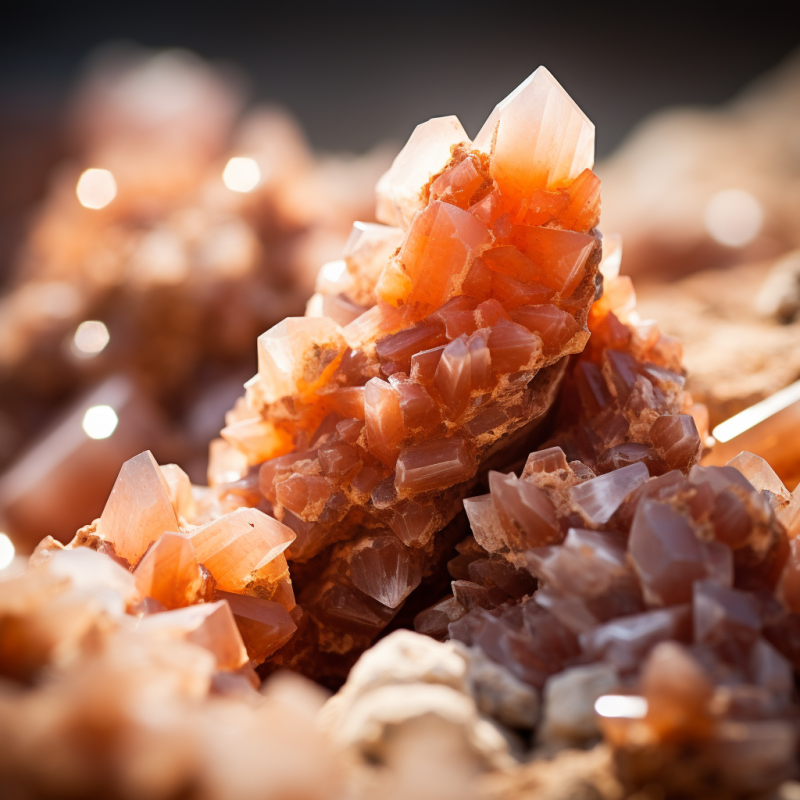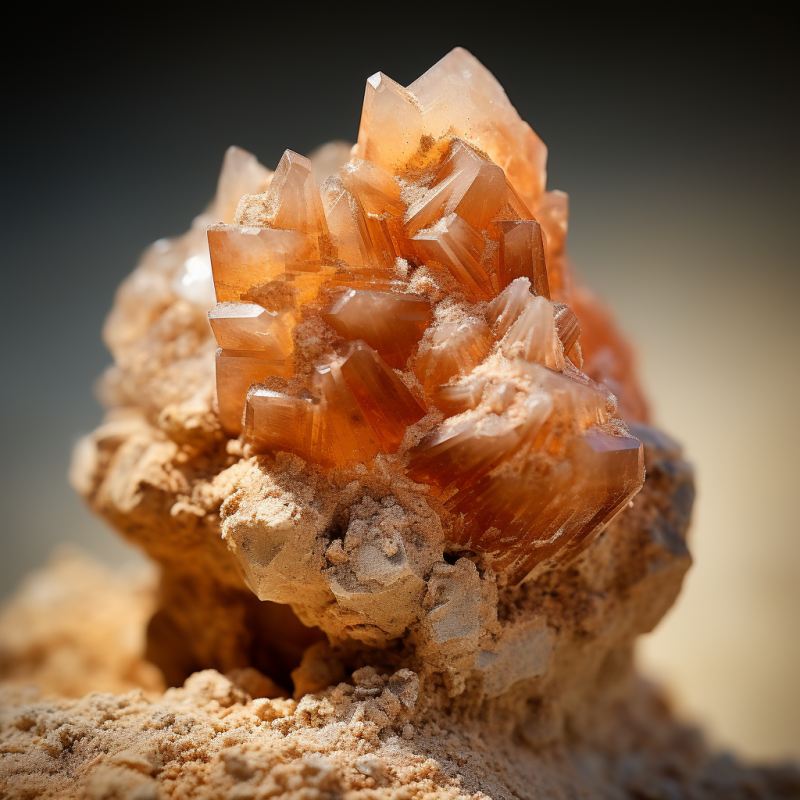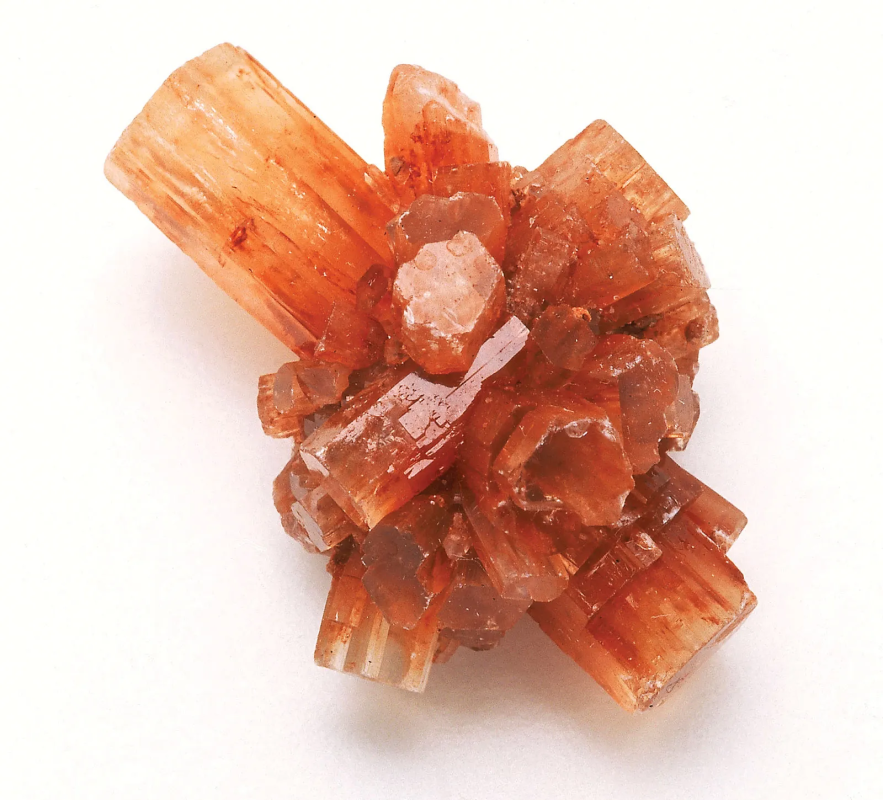Aragonite is a beautiful crystal with a warm, earthy glow. It often forms in intriguing cluster shapes, sometimes called “sputnik” or “star clusters,” which makes it quite eye-catching to collectors and crystal enthusiasts alike. Beyond its striking appearance, Aragonite is prized for its potential healing properties and spiritual benefits. Many people say Aragonite helps them feel calm, grounded, and centered in their everyday lives.
In this in-depth guide, we will explore everything you need to know about Aragonite, from its geological origins and physical characteristics to its metaphysical qualities, everyday uses, and more. We’ll also look at scientific viewpoints, cleaning and caring tips, and how to incorporate this crystal into your daily routine—so you can decide if Aragonite is right for you.
1. What Is Aragonite?
Aragonite is one of the three most common crystal forms of calcium carbonate, the others being calcite and vaterite. It was first discovered in Aragon, Spain—hence the name “Aragonite.” While it can be found in many places worldwide, including Morocco, Mexico, and China, its name still honors its Spanish roots.
Key points about Aragonite:
- Chemical Formula: CaCO₃ (calcium carbonate)
- Crystal System: Orthorhombic
- Colors: Typically white, brown, beige, yellowish, or occasionally blue
- Formation: Occurs in sedimentary rocks, hot springs, and the shells of certain sea creatures
Aragonite often forms as fascinating spherical clusters or radiating crystals. These “sputnik” or “star” shapes make it a favorite for collectors and those who love natural works of art.
2. Aragonite’s Geological Origins and Composition
To understand Aragonite’s healing properties, it helps to know a bit about how it forms and why it differs from other calcium carbonate minerals like calcite.
Formation Process
Aragonite can form in both organic and inorganic ways:
- Organic Formation: Many marine organisms (like corals and certain shellfish) produce Aragonite to form their shells or skeletons. Over time, these shells can accumulate on ocean floors and transform into sedimentary rock.
- Inorganic Formation: Aragonite also appears in cave systems as stalactites or stalagmites through a process involving mineral-rich water. Hot springs and geological vents are another source, where rapid mineral deposition favors the growth of Aragonite over calcite.
Physical and Chemical Properties
- Crystal Habit: Needles, prismatic, and fibrous
- Hardness: Approximately 3.5 to 4 on the Mohs scale
- Luster: Vitreous or resinous
- Cleavage: Distinct, but less perfect than calcite
Aragonite’s crystal lattice differs slightly from calcite’s. Although both share the same chemical formula, the atomic arrangement in Aragonite is more compact, which is why it forms unique, radiating clusters.
Importance in Science and Industry
Beyond the spiritual and aesthetic uses, Aragonite has practical roles:
- Water Purification: Crushed Aragonite sands are used in aquariums to stabilize pH levels.
- Carbon Capture Studies: Because it’s a form of calcium carbonate, scientists study Aragonite to better understand how carbon is stored in ocean ecosystems.
3. Aragonite’s Meaning and Symbolism
Many crystal enthusiasts view Aragonite as a stone of grounding, patience, and emotional stability. Because of its earthy colors and shapes, it’s often associated with nature, connecting us to the energy of the Earth.
Common symbolic themes linked to Aragonite include:
- Grounding and Stability: It is said to help anchor scattered energy, making it popular in meditation practices.
- Emotional Support: People often reach for Aragonite when they feel overwhelmed, as it’s believed to calm the mind.
- Strength and Discipline: Some consider it a “stone of discipline,” helping them stick to routines or long-term goals.
- Harmonizing Energy: Aragonite’s balanced, symmetrical crystal structure is thought to harmonize chaotic or conflicting energies in a room or within oneself.
While these ideas are not scientifically proven, many users claim personal benefits from working with Aragonite over time.
4. Healing Properties and Benefits
Crystals like Aragonite are often used in alternative wellness practices. They’re not a replacement for professional medical treatment, but many people find them helpful as complementary tools for emotional, mental, and spiritual support. Below are some commonly cited healing benefits of Aragonite.
4.1 Emotional Healing
Aragonite is prized for its grounding qualities. Some users place Aragonite clusters around their home to promote a peaceful environment. Others carry small pieces in a pocket to help stabilize their mood during high-stress situations.
Suggested Practices for Emotional Healing
- Daily Check-Ins: Hold or gently rub your Aragonite while taking a few deep breaths each morning or evening. This simple practice can become a mindfulness ritual that brings you back to the present moment.
- Stress Relief Visualization: Imagine roots growing from your feet into the ground, with the crystal in hand. Visualize any stress or negative thoughts flowing out of your body and into the Earth.
Science Note: While no direct scientific study confirms Aragonite’s emotional benefits, many people use grounding techniques to calm the mind. Grounding strategies—like visualization—have been studied in psychology for their stress-reducing effects.
4.2 Physical Wellness
Some crystal healers associate Aragonite with:
- Strengthening bones and joints due to its connection to calcium.
- Assisting with vitamin and mineral absorption in a more symbolic or energetic sense.
Remember, these associations are more traditional or spiritual rather than backed by medical science. Always consult a healthcare professional for any physical ailments.
4.3 Spiritual Growth
Aragonite is said to:
- Enhance spiritual connection by focusing your mind during meditation.
- Open pathways for deeper introspection, helping you better understand your own needs and challenges.
- Promote self-discipline in spiritual practices, like consistent journaling or daily gratitude exercises.
For individuals seeking a more profound sense of purpose or personal development, Aragonite can serve as a tangible reminder of their goals and values.
4.4 Chakra Connections
In many traditions, crystals are linked to specific chakras (energy centers in the body). Aragonite is most commonly linked to:
- Root Chakra (Muladhara): Because of its grounding qualities, Aragonite is widely believed to support the root chakra, promoting stability, security, and a sense of safety.
- Sacral Chakra (Svadhisthana): Some people also associate the warm hues of Aragonite with creative energies, which can relate to the sacral chakra.
Below is a simple reference table:
| Chakra | Associated Color | Aragonite’s Potential Effect |
|---|---|---|
| Root Chakra | Red/Black | ✔️ Grounding, security, stability |
| Sacral Chakra | Orange | ✔️ Creativity, emotional balance |
| Others | Varies | ❌ Less commonly associated |
Keep in mind that these associations are not universal truths but rather interpretive guidelines in crystal healing.
5. How to Use Aragonite
Now that we’ve covered its possible benefits, let’s explore how to actually use Aragonite in day-to-day life. From meditation sessions to home décor, there are various ways to incorporate this crystal into your daily routine.
5.1 Meditation
Meditation is one of the most popular ways to work with Aragonite. Since it is often seen as a “grounding stone,” meditating with Aragonite can help you feel more connected to the Earth and stable in your energy.
Steps to Meditate with Aragonite
- Find a Quiet Space: Choose a calm, quiet corner where you won’t be disturbed.
- Hold or Place the Crystal: Hold Aragonite in your hand or place it on the ground near you.
- Focus on Your Breathing: Take slow, deep breaths, keeping your attention on the crystal’s shape or texture.
- Visualize Grounding Energy: Envision roots or streams of light traveling from the crystal into your body, making you feel balanced and still.
5.2 Crystal Grids
Crystal grids combine multiple stones for a collective effect. If you want to amplify Aragonite’s calming energy, you can create a grid with other grounding stones like Hematite, Smoky Quartz, or Black Tourmaline.
How to Make a Simple Grid:
- Pick a Layout: Draw or print a geometric pattern (e.g., a flower of life or a simple circle).
- Choose Supporting Crystals: Pick complementary stones—like those mentioned above—for stability and calm.
- Center Stone: Place Aragonite at the center, serving as the “energy anchor.”
- Activate the Grid: Trace an imaginary line or wand around each crystal to “connect” the energies together.
5.3 Jewelry and Personal Wear
Wearing Aragonite as jewelry is a straightforward way to keep its energy close by throughout the day. Necklace pendants, bracelets, or pocket stones are popular. The warm, rustic tones of Aragonite also pair nicely with earthy outfits and bohemian styles.
✔️ Pros of Wearing Aragonite:
- Constant physical reminder of your intentions
- Natural color pairs well with casual or everyday wear
❌ Cons of Wearing Aragonite:
- Aragonite is relatively soft, so it’s not the most durable for daily wear (use protective settings in rings or pendants)
- Not as commonly available in mainstream jewelry shops
5.4 Home Décor and Feng Shui
Aragonite clusters can be striking conversation pieces in your living room or office. In Feng Shui, certain crystal placements are believed to improve the flow of energy (chi) in the space.
Suggested Placements:
- Living Room: To create a calm, welcoming vibe for family and visitors.
- Work Desk or Office: Helps you stay focused and grounded during stressful tasks or deadlines.
- Meditation Corner: Enhances a dedicated spiritual or self-care space.
5.5 Everyday Stress Relief
If you often feel anxious or stressed, consider having a small Aragonite stone in your bag or pocket. Use it as a “worry stone,” rubbing its surface when you need a moment of calm during busy days. While the stone itself can’t magically remove stress, the act of pausing and focusing on something tangible can be surprisingly soothing.
6. Cleansing and Recharging Aragonite
Cleansing is a common practice in crystal work, used to clear old or stagnant energies. Whether you believe in the energetic aspect or just want to keep your crystal physically clean, here are some tips:
Common Cleansing Methods
| Method | Safe for Aragonite? | How-To |
|---|---|---|
| Running Water | ❌ Not Recommended | May damage or dissolve Aragonite |
| Moonlight | ✔️ Yes | Place it on a windowsill overnight |
| Cleansing Herbs | ✔️ Yes | Pass Aragonite through sage/palo santo smoke |
| Sound Baths | ✔️ Yes | Use singing bowls or chimes |
| Brown Rice | ✔️ Yes | Bury the stone in rice for ~24 hrs |
| Salt | ❌ Use Caution | Salt can scratch or harm the surface |
Aragonite is softer than many other stones, so it’s best not to cleanse it under running water for long periods or leave it in water-based solutions. Moonlight and sound baths are gentle, effective methods.
Recharging Techniques
- Sunlight: Some people briefly place Aragonite in the morning sun to give it an “energetic recharge.” However, prolonged direct sunlight might fade its color.
- Crystal Clusters: You can also place your Aragonite on a larger Quartz or Amethyst cluster, which enthusiasts believe can recharge smaller crystals.
7. Combining Aragonite With Other Crystals
Aragonite’s warm, grounded energy makes it easy to combine with many different crystals, depending on your goals. Here are a few popular pairings:
- Smoky Quartz: Increases grounding properties, helping you to release negative energy and find stability.
- Rose Quartz: Adds a loving, gentle vibration, ideal for healing emotional wounds.
- Amethyst: Enhances spiritual awareness and calm, perfect for meditation or introspection.
- Black Tourmaline: Boosts protection and grounding, especially useful in stressful environments.
When combining crystals, focus on the overall intention you wish to set. Think of each stone as contributing a unique “ingredient” to the energy mix.
8. Frequently Asked Questions
Q1: How is Aragonite different from Calcite?
A: While both have the same chemical formula (CaCO₃), Aragonite forms under different conditions and has a different crystal structure. Aragonite typically appears in prismatic or radiating clusters, while Calcite can have more varied shapes (like rhombohedrons). Aragonite also tends to be slightly less stable and can transform into Calcite over geologic time.
Q2: Can Aragonite get wet?
A: It’s best to avoid soaking Aragonite in water because it’s relatively soft (3.5–4 on the Mohs scale) and may dissolve or lose its luster. Brief, gentle rinses could be fine, but prolonged contact with water is discouraged.
Q3: Is Aragonite expensive or hard to find?
A: It’s generally affordable compared to many other crystals. You can find beautiful sputnik clusters for a moderate price. More exotic colors or forms might cost more.
Q4: Which chakras are most affected by Aragonite?
A: Aragonite is commonly associated with the Root Chakra (for grounding) and sometimes the Sacral Chakra (for creativity and emotional flow).
Q5: Is there any scientific proof that Aragonite heals?
A: There is no scientific evidence that Aragonite directly cures illnesses or health conditions. Its use in healing is mainly based on anecdotal or traditional beliefs. Always consult a medical professional for health issues. Crystals like Aragonite can serve as supportive tools for mindfulness, relaxation, and emotional well-being.
Q6: How do I know if my Aragonite is real?
A: Real Aragonite clusters usually have a radiating pattern and are not perfectly symmetrical. If you suspect a fake, check for unusual uniformity in color or shape. Always buy from a reputable seller.
9. Bonus: Aragonite in Aquariums and Unique Uses
One unique use of Aragonite, beyond spiritual practices, is in aquariums. Hobbyists, especially those who keep saltwater or reef aquariums, often use Aragonite sand to help maintain stable pH levels. Aragonite slowly dissolves over time, releasing calcium and carbonate ions into the water. This helps buffer the aquarium’s pH, creating a healthier environment for corals and other marine life.
Why Aragonite Sand?
- pH Stability: Helps keep the water slightly alkaline, which is ideal for saltwater fish and coral.
- Aesthetics: Gives the tank a bright, natural look.
- Availability: Sold in most aquarium supply stores.
Note: If you plan to reuse Aragonite from an aquarium for spiritual or decorative purposes, rinse it thoroughly and allow it to dry. Some aquarium chemicals or salt residues might damage household surfaces or irritate skin.
Additional Unique Uses
- Garden Soil Amendment: In some cases, finely crushed Aragonite can be added to acidic soils to balance pH.
- Home Décor Projects: Polished Aragonite stones can be used in artistic mosaics or terrariums.
- Teaching Aid: Science teachers sometimes use Aragonite samples to demonstrate crystal formation, mineral identification, and oceanic carbon cycles.
10. Conclusion
Aragonite is more than just a pretty crystal—it’s a symbol of grounding energy, patience, and connection to the Earth. Whether you’re drawn to its warm glow for spiritual reasons, fascinated by its geological background, or just love how it looks in your home, Aragonite can be a meaningful addition to your life.
Key Takeaways
- Aragonite has a unique crystal structure, making it distinct from Calcite despite sharing the same chemical formula.
- It’s widely associated with grounding, emotional stability, and personal discipline.
- Many people use it in meditation, chakra work, crystal grids, and as beautiful décor pieces.
- It’s softer than some other stones, so be mindful of water damage and harsh environments.
- While not scientifically proven to cure ailments, it can serve as a wonderful tool for mindfulness, self-reflection, and adding an earthy vibe to your surroundings.
Join the Conversation!
How do you plan to use Aragonite in your daily life?
- Are you thinking about placing it on your work desk for stress relief?
- Using it in meditation or chakra balancing?
- Already have a stunning Aragonite cluster on your bookshelf?
We’d love to hear your thoughts and experiences. Drop a comment below to share your favorite Aragonite tips, ask questions, or swap stories with fellow crystal enthusiasts. Your insights might inspire someone else to discover a new way to connect with this earthy and captivating stone!
Disclaimer: The information in this article is for educational and entertainment purposes only. It does not substitute professional medical or psychological advice. Always consult qualified professionals for any health or wellness concerns.




















